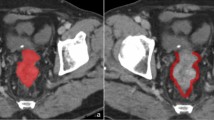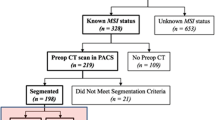Abstract
Objectives
Stratification of microsatellite instability (MSI) status in patients with colorectal cancer (CRC) improves clinical decision-making for cancer treatment. The present study aimed to develop a radiomics nomogram to predict the pre-treatment MSI status in patients with CRC.
Methods
A total of 762 patients with CRC confirmed by surgical pathology and MSI status determined with polymerase chain reaction (PCR) method were retrospectively recruited between January 2013 and May 2019. Radiomics features were extracted from routine pre-treatment abdominal pelvic computed tomography (CT) scans acquired as part of the patients’ clinical care. A radiomics nomogram was constructed using multivariate logistic regression. The performance of the nomogram was evaluated using discrimination, calibration, and decision curves.
Results
The radiomics nomogram incorporating radiomics signatures, tumor location, patient age, high-density lipoprotein expression, and platelet counts showed good discrimination between patients with non-MSI-H and MSI-H, with an area under the curve (AUC) of 0.74 [95% CI, 0.68–0.80] in the training cohort and 0.77 [95% CI, 0.68–0.85] in the validation cohort. Favorable clinical application was observed using decision curve analysis. The addition of pathological characteristics to the nomogram failed to show incremental prognostic value.
Conclusions
We developed a radiomics nomogram incorporating radiomics signatures and clinical indicators, which could potentially be used to facilitate the individualized prediction of MSI status in patients with CRC.
Key Points
• There is an unmet need to non-invasively determine MSI status prior to treatment. However, the traditional radiological evaluation of CT is limited for evaluating MSI status.
• Our non-invasive CT imaging-based radiomics method could efficiently distinguish patients with high MSI disease from those with low MSI disease.
• Our radiomics approach demonstrated promising diagnostic efficiency for MSI status, similar to the commonly used IHC method.





Similar content being viewed by others
Abbreviations
- AUC:
-
Area under the curve
- CRC:
-
Colorectal cancer
- CT:
-
Computed tomography
- dMMR:
-
Deficient MMR
- FFPE:
-
Paraffin-embedded
- HDL:
-
High-density lipoprotein
- ICCs:
-
Inter-observer intraclass correlation coefficients
- IHC:
-
Immunohistochemistry
- LASSO:
-
Least absolute shrinkage and selection operator
- MMR:
-
Mismatch repair
- MSI:
-
Microsatellite instability
- MSI-H:
-
High MSI
- MSI-L:
-
Low MSI
- MSS:
-
Microsatellite stability
- NCI:
-
National Cancer Institute
- PCR:
-
Polymerase chain reaction
- PLT:
-
Platelet
- pMMR:
-
Proficient MMR
- ROC:
-
Receiver operating characteristic
- ROI:
-
Regions of interest
References
Ferlay J, Colombet M, Soerjomataram I et al (2019) Estimating the global cancer incidence and mortality in 2018: GLOBOCAN sources and methods. Int J Cancer 144:1941–1953
Dekker E, Tanis PJ, Vleugels JLA, Kasi PM, Wallace MB (2019) Colorectal cancer. Lancet 394:1467–1480
Kawakami H, Zaanan A, Sinicrope FA (2015) Microsatellite instability testing and its role in the management of colorectal cancer. Curr Treat Options Oncol 16:30
Evrard C, Tachon G, Randrian V, Karayan-Tapon L, Tougeron D (2019) Microsatellite instability: diagnosis, heterogeneity, discordance, and clinical impact in colorectal cancer. Cancers (Basel) 11(10):1567
Liu W, Zhang D, Tan SA, Liu X, Lai J (2018) Sigmoid colon adenocarcinoma with isolated loss of PMS2 presenting in a patient with synchronous prostate cancer with intact MMR: Diagnosis and Analysis of the Family Pedigree. Anticancer Res 38:4847–4852
Vasen HF (2005) Clinical description of the Lynch syndrome [hereditary nonpolyposis colorectal cancer (HNPCC)]. Fam Cancer 4:219–225
Popat S, Hubner R, Houlston RS (2005) Systematic review of microsatellite instability and colorectal cancer prognosis. J Clin Oncol 23:609–618
Merok MA, Ahlquist T, Røyrvik EC et al (2013) Microsatellite instability has a positive prognostic impact on stage II colorectal cancer after complete resection: results from a large, consecutive Norwegian series. Ann Oncol 24:1274–1282
Li LS, Morales JC, Veigl M et al (2009) DNA mismatch repair (MMR)-dependent 5-fluorouracil cytotoxicity and the potential for new therapeutic targets. Br J Pharmacol 158:679–692
Mandal R, Samstein RM, Lee KW et al (2019) Genetic diversity of tumors with mismatch repair deficiency influences anti-PD-1 immunotherapy response. Science 364:485–491
Ludmir EB, Palta M, Willett CG, Czito BG (2017) Total neoadjuvant therapy for rectal cancer: an emerging option. Cancer 123:1497–1506
Tomasello G, Petrelli F, Ghidini M, Russo A, Passalacqua R, Barni S (2017) FOLFOXIRI plus bevacizumab as conversion therapy for patients with initially unresectable metastatic colorectal cancer: a systematic review and pooled analysis. JAMA Oncol 3:e170278
Fischer F, Baerenfaller K, Jiricny J (2007) 5-Fluorouracil is efficiently removed from DNA by the base excision and mismatch repair systems. Gastroenterology 133:1858–1868
Chalabi M, Fanchi LF, Dijkstra KK et al (2020) Neoadjuvant immunotherapy leads to pathological responses in MMR-proficient and MMR-deficient early-stage colon cancers. Nat Med 26:566–576
Diagnosis And Treatment Guidelines For Colorectal Cancer Working Group CSOCOC (2019) Chinese Society of Clinical Oncology (CSCO) diagnosis and treatment guidelines for colorectal cancer 2018 (English version). Chin J Cancer Res 31:117–134
Harada S, Morlote D (2020) Molecular pathology of colorectal cancer. Adv Anat Pathol 27:20–26
Gillies RJ, Kinahan PE, Hricak H (2016) Radiomics: Images Are More than Pictures, They Are Data. Radiology 278:563–577
Gardin I, Gregoire V, Gibon D et al (2019) Radiomics: principles and radiotherapy applications. Crit Rev Oncol Hematol 138:44–50
Yi X, Guan X, Zhang Y et al (2018) Radiomics improves efficiency for differentiating subclinical pheochromocytoma from lipid-poor adenoma: a predictive, preventive and personalized medical approach in adrenal incidentalomas. EPMA J 9:421–429
Rogers W, Thulasi SS, TAG R et al (2020) Radiomics: from qualitative to quantitative imaging. Br J Radiol 93:20190948
Badic B, Hatt M, Durand S et al (2019) Radiogenomics-based cancer prognosis in colorectal cancer. Sci Rep 9:9743
Yi X, Pei Q, Zhang Y et al (2019) MRI-based radiomics predicts tumor response to neoadjuvant chemoradiotherapy in locally advanced rectal cancer. Front Oncol 9:552
Wu J, Zhang Q, Zhao Y et al (2019) Radiomics analysis of iodine-based material decomposition images with dual-energy computed tomography imaging for preoperatively predicting microsatellite instability status in colorectal cancer. Front Oncol 9:1250
Golia PJS, Gagniere J, Chakraborty J et al (2019) Radiomics-based prediction of microsatellite instability in colorectal cancer at initial computed tomography evaluation. Abdom Radiol (NY) 44:3755–3763
Fan S, Li X, Cui X et al (2019) Computed tomography-based radiomic features could potentially predict microsatellite instability status in stage II colorectal cancer: a preliminary study. Acad Radiol 26:1633–1640
Lindor NM, Burgart LJ, Leontovich O et al (2002) Immunohistochemistry versus microsatellite instability testing in phenotyping colorectal tumors. J Clin Oncol 20:1043–1048
Gao C, Yan J, Luo Y et al (2020) The growth trend predictions in pulmonary ground glass nodules based on radiomic CT features. Front Oncol 10:580809
Szczypiński PM, Strzelecki M, Materka A, Klepaczko A (2009) MaZda--a software package for image texture analysis. Comput Methods Programs Biomed 94:66–76
Forghani R, Savadjiev P, Chatterjee A, Muthukrishnan N, Reinhold C, Forghani B (2019) Radiomics and artificial intelligence for biomarker and prediction model development in oncology. Comput Struct Biotechnol J 17:995–1008
Yi X, Liu Y, Zhou B et al (2021) Incorporating SULF1 polymorphisms in a pretreatment CT-based radiomic model for predicting platinum resistance in ovarian cancer treatment. Biomed Pharmacother 133:111013
Greenson JK, Huang SC, Herron C et al (2009) Pathologic predictors of microsatellite instability in colorectal cancer. Am J Surg Pathol 33:126–133
Dercle L, Lu L, Schwartz LH et al (2020) Radiomics response signature for identification of metastatic colorectal cancer sensitive to therapies targeting EGFR pathway. J Natl Cancer Inst 112(9):902–912
Boland CR, Goel A (2010) Microsatellite instability in colorectal cancer. Gastroenterology 138:2073–2087.e3
Song Y, Wang L, Ran W et al (2020) Effect of tumor location on clinicopathological and molecular markers in colorectal cancer in Eastern China patients: an analysis of 2,356 cases. Front Genet 11:96
Gaertner F, Massberg S (2019) Patrolling the vascular borders: platelets in immunity to infection and cancer. Nat Rev Immunol 19:747–760
Payandeh Z, Oho AUID, Khalili S et al (2020) PD-1/PD-L1-dependent immune response in colorectal cancer. J Cell Physiol 235:5461–5475
Ganjali S, Ricciuti B, Pirro M et al (2019) High-Density Lipoprotein Components and Functionality in Cancer: State-of-the-Art. Trends Endocrinol Metab 30:12–24
Acknowledgements
We thank Dr. Feiyue Zeng (Xiangya Hospital, Central South University) for helpful discussion and assistance in data analysis. We thank staff members in the Departments of Radiology, General Surgery, and Pathology at Xiangya Hospital for their efforts in collecting the information used in this study. Editing assistance was provided by Kerin Higa, PhD (City of Hope National Medical Center).
Funding
This study has received funding (in part) by the Natural Science Foundation of Hunan Province (2018JJ2641).
Author information
Authors and Affiliations
Corresponding authors
Ethics declarations
Guarantor
The scientific guarantor of this publication is Prof. Xiaoping Yi.
Conflict of interest
One of the authors of this manuscript (Peipei Pang) is an employee of GE Healthcare. The remaining authors declare no relationships with any companies whose products or services may be related to the subject matter of the article.
Statistics and biometry
One of the authors has significant statistical expertise.
Informed consent
Written informed consent was waived by the Institutional Review Board.
Ethical approval
Institutional Review Board approval was obtained.
Methodology
• Retrospective
• Case-control study
• Performed at one institution
Additional information
Publisher’s note
Springer Nature remains neutral with regard to jurisdictional claims in published maps and institutional affiliations.
Supplementary information
ESM 1
(DOCX 316 kb)
Rights and permissions
About this article
Cite this article
Pei, Q., Yi, X., Chen, C. et al. Pre-treatment CT-based radiomics nomogram for predicting microsatellite instability status in colorectal cancer. Eur Radiol 32, 714–724 (2022). https://doi.org/10.1007/s00330-021-08167-3
Received:
Revised:
Accepted:
Published:
Issue Date:
DOI: https://doi.org/10.1007/s00330-021-08167-3




